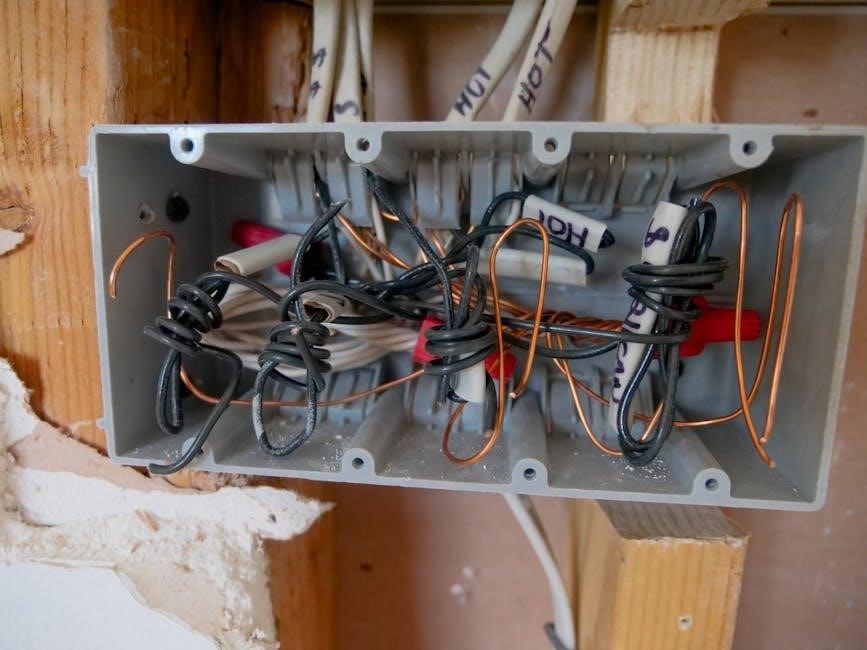Lippert Power Tongue Jacks revolutionize trailer handling, offering effortless operation and increased convenience for RV owners seeking simplified setup procedures.
What is a Lippert Power Tongue Jack?
A Lippert Power Tongue Jack is an electrically powered lifting device designed to replace the traditional manual tongue jack found on travel trailers, fifth wheels, and other towable recreational vehicles. It significantly reduces the physical effort required to raise and lower the trailer tongue, making hitching and unhitching a much simpler process.
Unlike manual jacks that rely on hand cranking, a Lippert Power Tongue Jack utilizes an electric motor to drive a gearbox, providing smooth and controlled lifting. These jacks are typically activated by a conveniently located switch, often mounted within easy reach of the operator. They offer a substantial upgrade in convenience, especially for those with heavier trailers or physical limitations. Modern models frequently include features like automatic leveling and remote control operation.
Benefits of Using a Power Tongue Jack
Power tongue jacks offer numerous advantages over traditional manual systems. The most prominent benefit is the significant reduction in physical strain; effortlessly raise and lower heavy trailers without strenuous cranking. This is particularly helpful for individuals with limited strength or mobility.
Beyond ease of use, power jacks drastically speed up the hitching and unhitching process, saving valuable time at the campsite. Precise control allows for accurate leveling, enhancing comfort and stability. Many models feature built-in overload protection, safeguarding the jack and trailer. Furthermore, the convenience encourages more frequent trailer use, maximizing enjoyment of your RV lifestyle. They represent a worthwhile investment for any serious RVer.

Understanding the Components

Key components include the motor, gearbox, control switch, jack tubes, foot plate, and mounting bracket – each vital for smooth, reliable operation of the system.
Jack Motor and Gearbox
The heart of the power tongue jack lies within its robust motor and gearbox assembly. Typically, these jacks utilize a 12-volt DC motor, providing ample power for lifting and lowering even heavily loaded trailers. The motor’s rotational force isn’t directly applied to the jack screw; instead, it’s channeled through a durable gearbox.
This gearbox serves a crucial purpose: it significantly increases torque while simultaneously reducing speed. This is essential because lifting a trailer requires substantial force, but doesn’t need to happen rapidly. The gear ratio is carefully engineered to balance power and control. The gearbox is usually sealed to protect against dust, moisture, and debris, ensuring longevity and reliable performance. Regular inspection for leaks or unusual noises is recommended to maintain optimal functionality.
Control Switch and Wiring
The control switch is the user interface for operating the power tongue jack, typically a simple up/down toggle or a momentary switch. These switches are designed for durability and weather resistance. Wiring connects the switch to the jack’s motor, often incorporating an inline fuse for circuit protection.
Proper wiring is paramount for safe and reliable operation. The wiring harness should be inspected regularly for damage, such as frayed wires or loose connections. A ground wire is essential for completing the electrical circuit and preventing shorts. Many systems utilize a dedicated power wire directly from the trailer’s battery, ensuring sufficient amperage. Always disconnect the battery before performing any electrical work on the jack to avoid accidental activation or electrical shock.
Upper and Lower Jack Tubes
The upper and lower jack tubes form the core structural components of the Lippert Power Tongue Jack. The lower tube is securely mounted to the trailer’s A-frame, providing a stable base. The upper tube houses the internal drive mechanism and extends/retracts to raise and lower the trailer.
These tubes are typically constructed from heavy-duty steel for strength and durability, often with a corrosion-resistant coating. The inner tube slides within the outer tube, guided by bearings or bushings to ensure smooth operation. Regular inspection for dents, bends, or signs of corrosion is crucial. Maintaining cleanliness of the tubes prevents binding and ensures optimal performance. Proper alignment of these tubes is vital for preventing uneven wear and extending the jack’s lifespan.
Foot Plate and Mounting Bracket
The foot plate is the crucial ground contact point of the Lippert Power Tongue Jack, distributing the trailer’s weight across the parking surface. It’s typically a wide, flat steel plate designed for stability, often featuring a textured surface for improved grip.
The mounting bracket securely fastens the jack assembly to the trailer’s A-frame. It’s engineered to withstand significant loads and stresses during operation. Inspect the bracket regularly for cracks, bends, or loose fasteners. Ensure all bolts are tightened to the manufacturer’s specified torque. A damaged mounting bracket compromises the jack’s stability and safety. Proper installation and maintenance of both the foot plate and bracket are essential for reliable and secure trailer support.

Operating Your Lippert Power Tongue Jack
Smooth and efficient trailer leveling is now achievable with your Lippert Power Tongue Jack; follow these instructions for optimal performance and safety.
Initial Setup and Pre-Operation Checks
Before your first use, ensure the jack is securely mounted to your trailer’s A-frame, verifying all bolts are tightened to the manufacturer’s specified torque. Inspect the wiring harness for any damage – frayed wires or loose connections can compromise operation.
Connect the jack’s wiring to your trailer’s power source, typically a 12-volt system. Confirm proper polarity; reversed polarity can damage the motor. Visually inspect the jack tube for any bends or dents, which could indicate prior damage.
Perform a short test by briefly activating the up and down functions. Listen for unusual noises and observe the jack’s movement for smoothness. Ensure the foot plate makes solid contact with the ground before applying significant weight. Finally, familiarize yourself with the location of the manual override handle and how to engage it.
Raising the Trailer
To raise the trailer, ensure the area around the jack is clear of obstructions and personnel. Press and hold the “Up” button on the control switch. Observe the jack extending, lifting the trailer’s tongue. Raise the trailer only to the height necessary to disconnect from the towing vehicle – avoid overextending.
Maintain constant visual contact during the raising process. If the jack encounters resistance or moves unevenly, immediately release the button and investigate the cause. Never stand directly in the path of the extending jack.
Once the desired height is reached, release the “Up” button. The jack will automatically stop. Before disconnecting the safety chains and electrical connection, double-check the jack’s stability and ensure it’s firmly supporting the trailer’s weight.
Lowering the Trailer
Before lowering the trailer, confirm the hitch receiver on the towing vehicle is properly aligned with the trailer’s coupler. Ensure the area around the jack is clear of people and obstacles. Press and hold the “Down” button on the control switch.
Carefully observe the jack retracting, gently lowering the trailer’s tongue. Lower the trailer slowly and steadily, avoiding any sudden drops. If resistance is felt, immediately release the button and assess the situation. Never position yourself under the lowering trailer tongue.
Once the coupler is close to the hitch, reduce pressure on the “Down” button for finer control. Carefully align and connect the coupler to the hitch. Finally, release the button completely once secured.
Emergency Manual Operation
In the event of power failure or jack malfunction, manual operation is crucial. Locate the manual override crank handle, typically stored with the jack components. Insert the crank handle into the designated drive socket on the jack’s gearbox.
Turning the crank clockwise will retract the jack, while counter-clockwise rotation extends it. Apply steady, controlled force; avoid jerky movements. Manual operation requires significantly more effort than powered operation. Ensure the jack is securely positioned before attempting to move the trailer.
Once the trailer is in the desired position, remove the crank handle and store it safely. Remember manual operation is for emergencies only and should not be used for routine adjustments.

Troubleshooting Common Issues
Addressing operational hiccups with your Lippert Power Tongue Jack ensures continued smooth trailer leveling and hitching, preventing frustrating delays.
Jack Not Responding to Switch
If your Lippert Power Tongue Jack fails to respond when you activate the control switch, begin with the simplest checks. First, verify the power source – is the trailer battery fully charged and properly connected? A loose connection or depleted battery is a frequent culprit.
Next, inspect the wiring harness connecting the switch to the jack motor. Look for any visible damage, such as frayed wires or loose connectors. Ensure the connections are clean and secure. A multimeter can be used to test for continuity in the wiring.
Also, check the inline fuse protecting the jack’s electrical circuit. A blown fuse will immediately prevent operation. Replace it with a fuse of the correct amperage rating. Finally, confirm the control switch itself is functioning correctly; sometimes, the switch can fail internally.
Slow or Erratic Jack Movement
Experiencing slow or erratic movement from your Lippert Power Tongue Jack often indicates a lubrication issue or a partially obstructed mechanism. Initially, thoroughly lubricate the jack’s internal gears and screw shaft using a high-quality grease specifically designed for heavy-duty applications. Refer to the maintenance section for detailed lubrication procedures.
Subsequently, inspect the jack tube for any bends or damage that might be causing friction. Ensure the jack is operating vertically and isn’t binding against any obstacles. Check the foot plate for proper contact with the ground; uneven support can strain the motor.
Furthermore, a low battery voltage can also contribute to sluggish performance. Confirm the trailer battery is adequately charged. Lastly, examine the jack motor for any signs of overheating or unusual noises, which could signal a more serious mechanical problem.
Jack Won’t Fully Retract or Extend
If your Lippert Power Tongue Jack fails to fully retract or extend, the issue frequently stems from a limit switch malfunction or an obstruction within the jack’s travel path. First, verify that nothing is physically blocking the jack’s movement – check for debris, rocks, or uneven ground.
Next, inspect the limit switches, located near the upper and lower portions of the jack tube. These switches signal the motor to stop at the fully retracted and extended positions. A faulty switch may prevent complete operation.
Additionally, ensure the jack’s wiring harness is securely connected and free from damage. A loose connection can disrupt the signal to the motor. Finally, a low battery can also cause incomplete cycles; confirm adequate power. If problems persist, professional servicing is recommended.

Overload Protection Activation
Lippert Power Tongue Jacks incorporate overload protection to prevent motor damage from excessive weight or strain. If the jack stops mid-operation and the overload indicator illuminates, immediately cease operation. This indicates the jack is experiencing a load beyond its rated capacity.

First, verify the trailer is properly supported and level. Uneven terrain can create undue stress. Second, ensure the trailer’s weight is distributed correctly and isn’t excessively concentrated on the tongue.
To reset the overload protection, fully retract the jack, disconnect power for approximately 30 seconds, and then reconnect. Attempt operation again, but if the overload activates repeatedly, reduce the load or consult a qualified technician. Ignoring this warning can lead to permanent jack failure.

Maintenance and Care
Regular maintenance ensures optimal performance and longevity of your Lippert Power Tongue Jack; consistent care prevents costly repairs and extends its lifespan.
Lubrication Procedures
Proper lubrication is crucial for smooth operation and preventing wear on your Lippert Power Tongue Jack. Begin by thoroughly cleaning the jack tube, removing any dirt or debris with a mild detergent and water. Apply a high-quality, marine-grade grease to the inner and outer jack tubes – specifically, the telescoping sections.
Ensure the grease is evenly distributed by fully extending and retracting the jack several times after application. Pay close attention to the gearbox; it requires periodic greasing as well. Locate the grease fitting on the gearbox and use a grease gun to inject grease until fresh grease appears. Avoid over-greasing, as this can attract dirt. Finally, inspect the foot plate and mounting bracket, applying grease to any moving parts or pivot points. Regular lubrication, ideally every six months or after extended use, will significantly prolong the life of your power tongue jack.
Cleaning and Corrosion Prevention
Regular cleaning is essential to prevent corrosion and maintain the functionality of your Lippert Power Tongue Jack. After each use, especially in harsh environments, wipe down the jack tube with a damp cloth to remove dirt, road salt, and other contaminants. For stubborn grime, use a mild soap solution.
Inspect the jack for any signs of rust or corrosion. If detected, use a wire brush to remove the rust, then apply a rust inhibitor or protective coating. Pay particular attention to the electrical connections, ensuring they are clean and free of corrosion. Applying dielectric grease to the connections will help prevent future corrosion. Consider using a corrosion-resistant spray on the entire jack for added protection, especially if you live in a coastal area or frequently travel in wet conditions. Consistent cleaning and preventative measures will extend the lifespan of your jack.

Winterization Steps
Proper winterization is crucial to protect your Lippert Power Tongue Jack from freezing temperatures and potential damage. Before storing your trailer for the winter, fully retract the jack. Apply a silicone-based lubricant generously to the jack tube, ensuring complete coverage. This prevents ice formation and keeps the internal components moving freely.
Disconnect the power supply to the jack and consider covering the control switch with a waterproof cover. Inspect the wiring for any damage and repair as needed. If possible, store the trailer indoors or cover it with a waterproof tarp to shield the jack from the elements. Regularly check the jack throughout the winter and reapply lubricant if necessary. These steps will help ensure your jack is ready for use when spring arrives.
Long-Term Storage Guidelines
For extended periods of inactivity, beyond a typical winter, meticulous storage is essential for your Lippert Power Tongue Jack’s longevity. After completing winterization steps, ensure the jack remains fully retracted. Store the trailer in a dry, covered location, shielded from direct sunlight and harsh weather conditions.
Periodically – every few months – briefly operate the jack (if possible with a trickle charger connected to the trailer battery) to circulate lubricant and prevent component stagnation. Inspect the jack tube and footplate for corrosion; address any issues promptly. Keep the area around the jack clear of debris. Following these guidelines minimizes wear and tear, guaranteeing reliable performance when you’re ready to hit the road again.

Safety Precautions
Always maintain a safe distance during operation, and never place hands near moving parts; awareness prevents injuries when utilizing the power tongue jack.
Safe Operating Distances
Maintaining appropriate distances during operation is crucial for safety. Keep all bystanders, including children and pets, at least 10 feet away from the jack during raising, lowering, and any operational checks. This buffer zone minimizes the risk of accidental contact with moving parts or potential instability during the process.
Never stand directly in front of or behind the jack while it’s in motion. Position yourself to the side, allowing for a clear view of the jack’s movement and providing an escape path if needed. Avoid reaching under or around the trailer while the jack is operating. Ensure the area around the jack is clear of obstructions before initiating any movement.
Remember, the jack provides significant lifting force, and accidental contact can result in serious injury. Prioritize awareness and maintain a safe perimeter at all times.
Avoiding Pinch Points
Lippert Power Tongue Jacks possess several potential pinch points where hands or clothing could become caught during operation or maintenance. The areas where the inner and outer jack tubes slide are primary concerns; keep clear during extension and retraction.
Exercise extreme caution around the gearbox and motor housing, as these contain rotating parts. Never attempt to disassemble or repair the jack without disconnecting the power source first. Be mindful of the footplate area, especially when lowering the jack onto uneven ground – objects can become trapped.
Always visually inspect the jack before each use, ensuring no tools or debris are near moving parts. Avoid wearing loose clothing or jewelry that could get snagged. Prioritize hand placement and maintain constant awareness of the jack’s movement to prevent accidental injuries.
